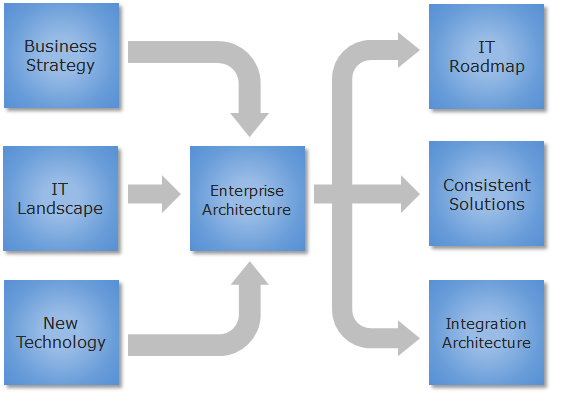Enterprise Architecture can be a bit nebulous. Without a clear message on
value proposition and deliverable expectations, the Enterprise Architect can
simply be a boondoggle in the organization. Instead, and effective Enterprise
Architect is positioned to add immense value to the organization in the form
of seized opportunities and minimized costs. Below are thoughts on how to be an
effective Enterprise Architect.
Mission and Vision
Create a mission that encompasses the Enterprise Architect’s value to the
organization. Communicate a vision that illustrates how to achieve that
value. Make the vision understandable to all. Software architects of all
types must bridge the gap of technology and business. No more so than the
Enterprise Architect (EA). The EA must thoroughly understand the mission of
the organization and craft a vision for the EA role that aligns and promotes
the organizational mission and vision. The mission and vision must be
communicated in simple terms that everyone can relate to. It is not the place
for technical jargon or faddish buzzwords that alienate those who don’t see
how the EA helps their bottom line.
Business Strategy
Work with business leaders to identify future changes to the IT
landscape. Do not expect business leaders to spell out what sort of IT
investments are necessary. Instead, walk them through SWOT conversations to
determine how IT can enable strengths and be ready for opportunities.
Similarly, listen for how IT is be holding the business back and creating
obstacles or stumbling blocks for business progress.
IT Landscape
Understand the current IT landscape thoroughly. Know the applications that the
organization uses. Be familiar with which are vended and which ones are
bespoke. Know the languages, databases, and other tools used to create the
custom applications. Understand the organizations infrastructure. Make sure
you have handle on “traditional” physical infrastructure versus an
on-premise cloud. Know if on-premise cloud supports IaaS or if it just uses manually configured resources on a virtual
platform. Create a definitive application list. Include costs for licensing
and number of people required to support it. Assess whether each application
is an industry standard or an outlier. If the application is unusual, then
determine if it supports a competitive edge or if it is just someone’s pet.
Get fee for the talent pool- determine if those technologies growing or
shrinking. Confirm the supporting vendors still
actively develop those technologies. Ensure the disaster recovery strategy is
well-defined. It may not be the EA role to actually implement the EA plan,
but it is necessary to assess each application and know how disaster recover
will work.
Emerging and Ending Technology
What technologies can benefit the organization? What technologies do the
users expect the IT department to employ? What technologies are reaching
end-of-life? What transition paths have the vendor(s) created to move to
current technology?
IT Roadmap
Starting with the current landscape and being mindful of the business strategy
and emerging technologies, project changes into the future. Changes are big
and small. There should be a timeline and cost associated with each change.
Cost is a function of effort to migrate (including develop, deploy, and test),
license costs for new tech, doubled infrastructure during the transition
period. Users may require training for any new changes.
Consistent Solutions
Identify similarities across problem spaces and solution patterns. Even if
the exact same solution cannot be used across problem spaces, apply the same
solution patterns as much as possible. This includes everything from database
and language choice to documentation standards. Create a culture of
mentorship and information sharing. Encourage an open door policy so that
teams share information freely about what’s happening in their world. Be
intentional in reviewing and understanding challenges and requirements before
dictating solutions. Help teams arrive and effective solutions on their own.
Integration Architecture
Create a catalog of established integration patterns. Evaluate each new
solution in terms of fit within existing solution patterns. This has to be
balanced with maintaining investments with moving forward into the future.
Remind yourself of the Amazon edict that was sent out in 2002 – everything is
connected through a service. Decide the platform and structure of “pull”
interfaces. Determine how events and streaming interfaces should integrate.
Make informed decisions about new and emerging standards versus established
players.
Conclusion
The Enterprise Architect is an invaluable role. However, it’s very easy for
the business community to miss the connection between the EA role and
promoting the business as a whole. The areas outlined above scratch the
surface but can be a useful reminder for maintaining relevance – to both
business and technology colleagues. Get in front of the business users on a
regular basis. Stay up on technology and always be learning. Build and
maintain relationships to help others in their mission.
